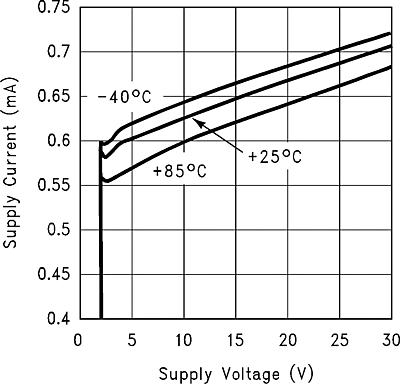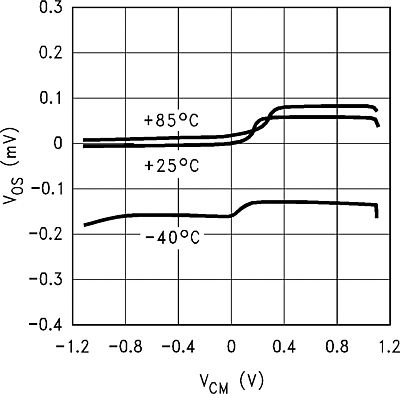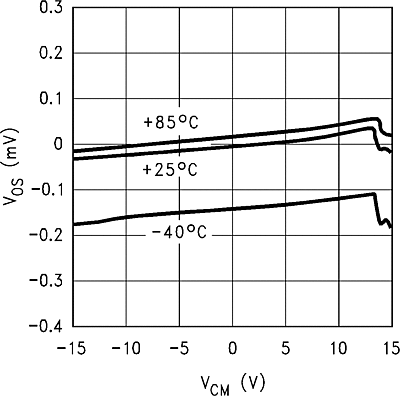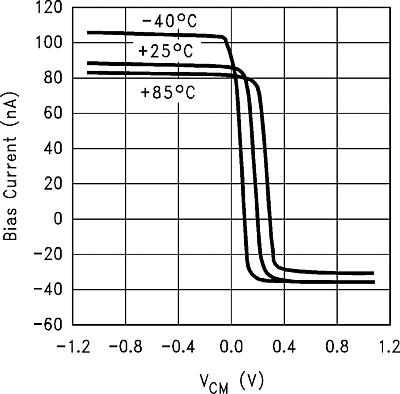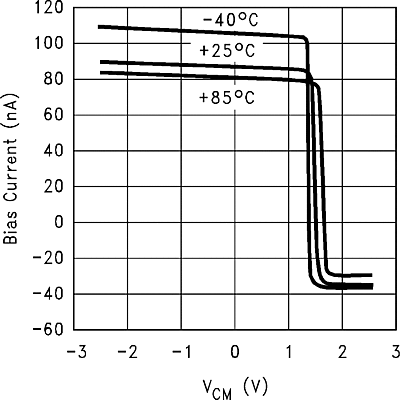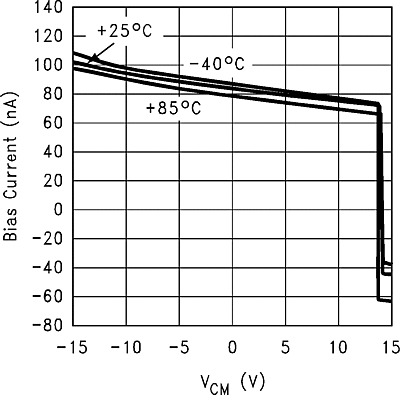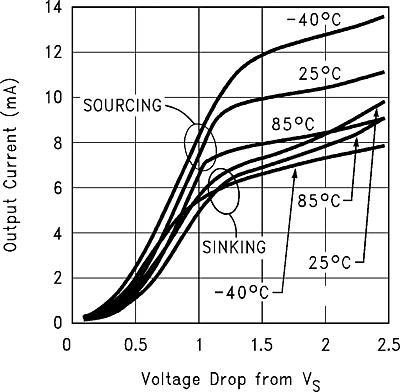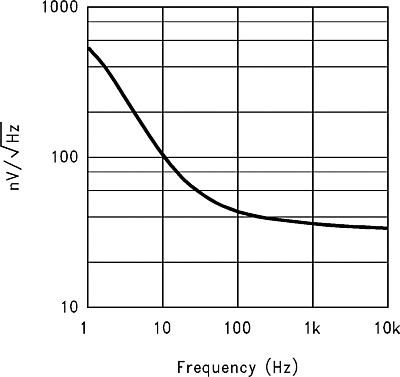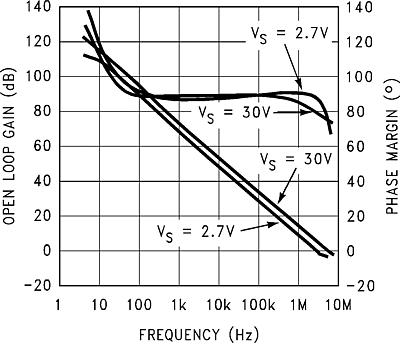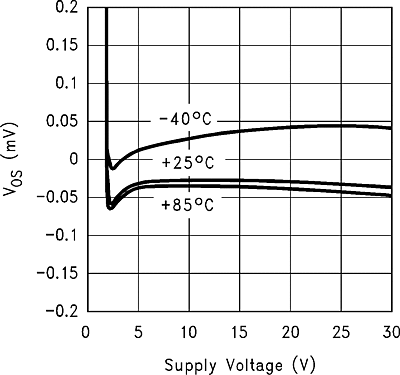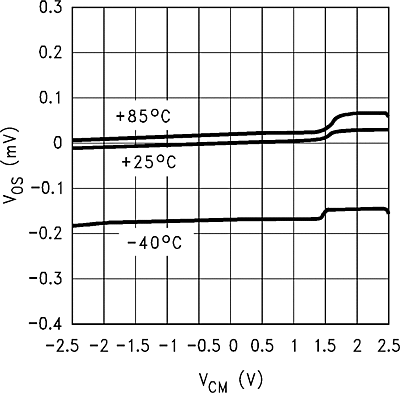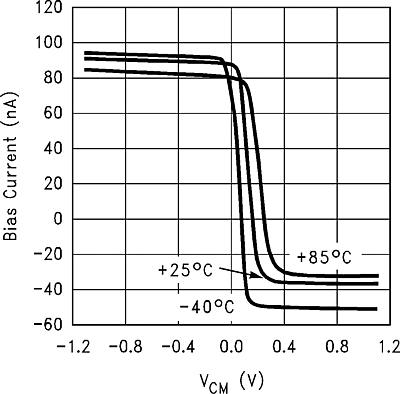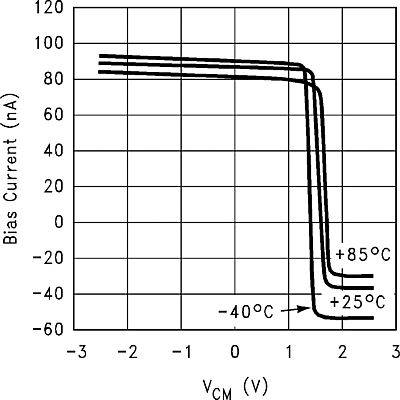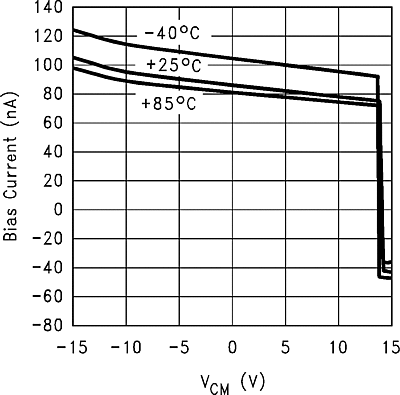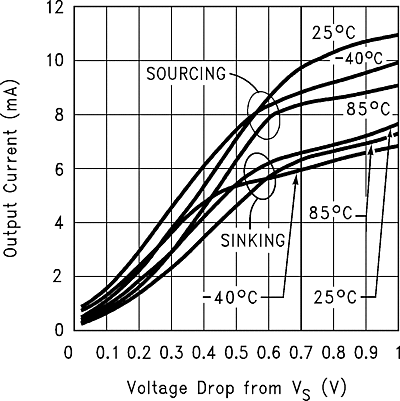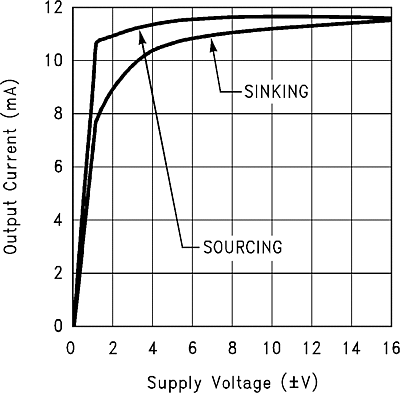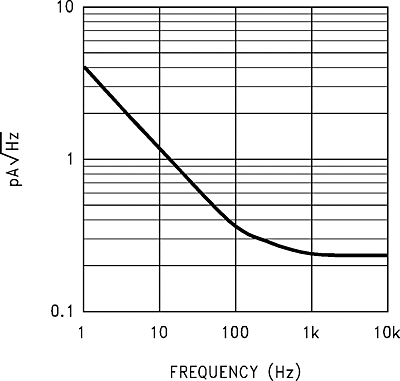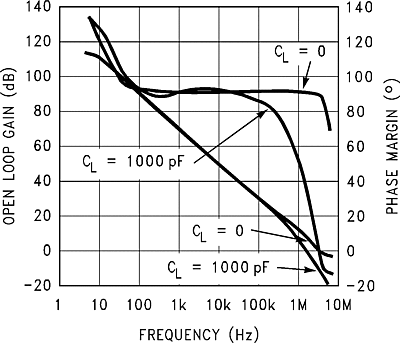JAJS911I August 1999 – May 2016 LM7301
PRODUCTION DATA.
- 1 特長
- 2 アプリケーション
- 3 概要
- 4 改訂履歴
- 5 Pin Configuration and Functions
- 6 Specifications
- 7 Detailed Description
- 8 Applications and Implementation
- 9 Power Supply Recommendations
- 10Layout
- 11デバイスおよびドキュメントのサポート
- 12メカニカル、パッケージ、および注文情報
パッケージ・オプション
メカニカル・データ(パッケージ|ピン)
サーマルパッド・メカニカル・データ
発注情報
6 Specifications
6.1 Absolute Maximum Ratings
over operating free-air temperature range (unless otherwise noted)(1)(2)| MIN | MAX | UNIT | ||
|---|---|---|---|---|
| Differential input voltage | 15 | V | ||
| Voltage at input and output pin | (V+) + 0.3 | (V–) – 0.3 | V | |
| Supply voltage (V+ − V−) | 35 | V | ||
| Current at input pin | ±10 | mA | ||
| Current at output pin(2) | ±20 | mA | ||
| Current at power supply pin | 25 | mA | ||
| Junction temperature, TJ(3) | 150 | °C | ||
| Storage temperature, Tstg | –65 | 150 | °C | |
(1) Stresses beyond those listed under Absolute Maximum Ratings may cause permanent damage to the device. These are stress ratings only, which do not imply functional operation of the device at these or any other conditions beyond those indicated under Recommended Operating Conditions. Exposure to absolute-maximum-rated conditions for extended periods may affect device reliability.
(2) If Military/Aerospace specified devices are required, contact the Texas Instruments Sales Office/Distributors for availability and specifications.
6.2 ESD Ratings
| VALUE | UNIT | |||
|---|---|---|---|---|
| V(ESD) | Electrostatic discharge | Human-body model (HBM), per ANSI/ESDA/JEDEC JS-001(1) | ±2500 | V |
(1) JEDEC document JEP155 states that 2500-V HBM allows safe manufacturing with a standard ESD control process.
6.3 Recommended Operating Conditions
over operating free-air temperature range (unless otherwise noted)(1)| MIN | NOM | MAX | UNIT | ||
|---|---|---|---|---|---|
| Supply voltage | 1.8 | 32 | V | ||
| Operating temperature (3) | –40 | 85 | °C | ||
| Package thermal resistance (RθJA)(3) | 5-pin SOT-23 | 325 | 325 | °C/W | |
| 8-pin SOIC | 165 | 165 | °C/W | ||
6.4 Thermal Information
| THERMAL METRIC(1) | LM7301 | UNIT | ||
|---|---|---|---|---|
| DBV (SOT-23) | D (SOIC) | |||
| 5 PINS | 8 PINS | |||
| RθJA | Junction-to-ambient thermal resistance | 169 | 120 | °C/W |
| RθJC(top) | Junction-to-case (top) thermal resistance | 122 | 65 | °C/W |
| RθJB | Junction-to-board thermal resistance | 30 | 61 | °C/W |
| ψJT | Junction-to-top characterization parameter | 17 | 16 | °C/W |
| ψJB | Junction-to-board characterization parameter | 29 | 60 | °C/W |
| RθJC(bot) | Junction-to-case (bottom) thermal resistance | N/A | N/A | °C/W |
(1) For more information about traditional and new thermal metrics, see the Semiconductor and IC Package Thermal Metrics application report, SPRA953.
6.5 Electrical Characteristics: 5-V DC
Unless otherwise specified, all limits ensured for TA = 25°C, V+ = 5V, V− = 0V, VCM = VO = V+/2 and RL > 1MΩ to V+/2 unless noted that limits apply at the temperature extremes.(5) (4)(6)| PARAMETER | TEST CONDITIONS | MIN | TYP | MAX | UNIT | ||
|---|---|---|---|---|---|---|---|
| VOS | Input offset voltage | TA = 25°C | 0.03 | 6 | mV | ||
| TA = TJ | 8 | ||||||
| TCVOS | Input offset voltage average drift | TA = TJ | 2 | μV/°C | |||
| IB | Input bias current | VCM = 0 V | TA = 25°C | 90 | 200 | nA | |
| TA = TJ | 250 | ||||||
| VCM = 5 V | TA = 25°C | −40 | −75 | ||||
| TA = TJ | −85 | ||||||
| IOS | Input offset current | VCM = 0 V | TA = 25°C | 0.7 | 70 | nA | |
| TA = TJ | 80 | ||||||
| VCM = 5 V | TA = 25°C | 0.7 | 55 | ||||
| TA = TJ | 65 | ||||||
| RIN | Input resistance, CM | 0 V ≤ VCM ≤ 5 V | 39 | MΩ | |||
| CMRR | Common mode rejection ratio | 0 V ≤ VCM ≤ 5 V | TA = 25°C | 70 | 88 | dB | |
| TA = TJ | 67 | ||||||
| 0 V ≤ VCM ≤ 3.5 V | 93 | ||||||
| PSRR | Power supply rejection ratio | 2.2 V ≤ V+ ≤ 30 V | TA = 25°C | 87 | 104 | dB | |
| TA = TJ | 84 | ||||||
| VCM | Input common-mode voltage range | CMRR ≥ 65 dB | 5.1 | V | |||
| −0.1 | |||||||
| AV | Large signal voltage gain | RL = 10 kΩ VO = 4 VPP |
TA = 25°C | 14 | 71 | V/mV | |
| TA = TJ | 10 | ||||||
| VO | Output swing | RL = 10 kΩ | TA = 25°C | 0.07 | 0.12 | V | |
| 4.93 | |||||||
| TA = TJ | 4.88 | 0.15 | |||||
| 4.85 | |||||||
| RL = 2 kΩ | TA = 25°C | 0.14 | 0.2 | ||||
| 0.22 | |||||||
| TA = TJ | 4.80 | 4.87 | |||||
| 4.78 | |||||||
| ISC | Output short-circuit current | Sourcing | TA = 25°C | 8 | 11 | mA | |
| TA = TJ | 5.5 | ||||||
| Sinking | TA = 25°C | 6 | 9.5 | ||||
| TA = TJ | 5 | ||||||
| IS | Supply current | TA = 25°C | 0.6 | 1.1 | mA | ||
| TA = TJ | 1.24 | ||||||
6.6 Electrical Characteristics: AC
TA = 25°C, V+ = 2.2 V to 30 V, V− = 0 V, VCM = VO = V+/2 and RL > 1 MΩ to V+/2(6)| PARAMETER | TEST CONDITIONS | TYP (4) | UNIT | |
|---|---|---|---|---|
| SR | Slew rate | ±4-V Step at VS ±6 V | 1.25 | V/µs |
| GBW | Gain-bandwidth product | f = 100 kHz, RL = 10 kΩ | 4 | MHz |
| en | Input-referred voltage noise | f = 1 kHz | 36 | nV/√Hz |
| in | Input-referred current noise | f = 1 kHz | 0.24 | pA/√Hz |
| T.H.D. | Total harmonic distortion | f = 10 kHz | 0.006% | |
6.7 Electrical Characteristics: 2.2-V DC
Unless otherwise specified, all limits ensured for TA = 25°C, V+ = 2.2 V, V− = 0 V, VCM = VO = V+/2 and RL > 1 MΩ to V+/2 unless noted that limits apply at the temperature. (4)(5)| PARAMETER | TEST CONDITIONS | MIN | TYP | MAX | UNIT | ||
|---|---|---|---|---|---|---|---|
| VOS | Input offset voltage | TA = 25°C | 0.04 | 6 | mV | ||
| TA = TJ | 8 | ||||||
| TCVOS | Input offset voltage average drift | TA = TJ | 2 | µV/°C | |||
| IB | Input bias current | VCM = 0 V | TA = 25°C | 89 | 200 | nA | |
| TA = TJ | 250 | ||||||
| VCM = 2.2 V | TA = 25°C | −75 | −35 | ||||
| TA = TJ | −85 | ||||||
| IOS | Input offset current | VCM = 0 V | TA = 25°C | 0.8 | 70 | nA | |
| TA = TJ | 80 | ||||||
| VCM = 2.2 V | TA = 25°C | 0.4 | 55 | ||||
| TA = TJ | 65 | ||||||
| RIN | Input resistance | 0 V ≤ VCM ≤ 2.2 V | 18 | MΩ | |||
| CMRR | Common-mode rejection ratio | 0 V ≤ VCM ≤ 2.2 V | TA = 25°C | 60 | 82 | dB | |
| TA = TJ | 56 | ||||||
| PSRR | Power supply rejection ratio | 2.2 V ≤ V+ ≤ 30 V | TA = 25°C | 87 | 104 | dB | |
| TA = TJ | 84 | ||||||
| VCM | Input common-mode voltage range | CMRR > 60 dB | 2.3 | V | |||
| –0.1 | |||||||
| AV | Large signal voltage gain | RL = 10 kΩ VO = 1.6 VPP |
TA = 25°C | 6.5 | 46 | V/mV | |
| TA = TJ | 5.4 | ||||||
| VO | Output swing | RL = 10 kΩ | TA = 25°C | 0.05 | 0.08 | V | |
| 2.15 | |||||||
| TA = TJ | 0.1 | ||||||
| RL = 2 kΩ | TA = 25°C | 0.09 | 0.13 | ||||
| TA = TJ | 0.14 | ||||||
| ISC | Output short-circuit current | Sourcing | TA = 25°C | 8 | 10.9 | mA | |
| TA = TJ | 5.5 | ||||||
| Sinking | TA = 25°C | 6 | 7.7 | ||||
| TA = TJ | 5 | ||||||
| IS | Supply current | TA = 25°C | 0.57 | 0.97 | mA | ||
| TA = TJ | 1.24 | ||||||
6.8 Electrical Characteristics: 30-V DC
Unless otherwise specified, all limits ensured for TA = 25°C, V+ = 30 V, V− = 0 V, VCM = VO = V+/2 and RL > 1 MΩ to V+/2 unless noted that limits apply at the temperature(6)| PARAMETER | TEST CONDITIONS | MIN | TYP | MAX | UNIT | ||
|---|---|---|---|---|---|---|---|
| VOS | Input offset voltage | 0.04 | 6 | mV | |||
| 8 | |||||||
| TCVOS | Input offset voltage average drift | TA = TJ | 2 | μV/°C | |||
| IB | Input bias current | VCM = 0 V | TA = 25°C | 103 | 300 | nA | |
| TA = TJ | 500 | ||||||
| VCM = 30 V | TA = 25°C | −100 | −50 | ||||
| TA = TJ | −200 | ||||||
| IOS | Input offset current | VCM = 0 V | TA = 25°C | 1.2 | 90 | nA | |
| TA = TJ | 190 | ||||||
| VCM = 30 V | TA = 25°C | 0.5 | 65 | ||||
| TA = TJ | 135 | ||||||
| RIN | Input resistance | 0 V ≤ VCM ≤ 30 V | 200 | MΩ | |||
| CMRR | Common mode rejection ratio | 0 V ≤ VCM ≤ 30 V | TA = 25°C | 80 | 104 | dB | |
| TA = TJ | 78 | ||||||
| 0 V ≤ VCM ≤ 27 V | TA = 25°C | 90 | 115 | ||||
| TA = TJ | 88 | ||||||
| PSRR | Power supply rejection ratio | 2.2 V ≤ V+ ≤ 30 V | TA = 25°C | 87 | 104 | dB | |
| TA = TJ | 84 | ||||||
| VCM | Input common-mode voltage range | CMRR > 80 dB | 30.1 | V | |||
| −0.1 | |||||||
| AV | Large signal voltage gain | RL = 10 kΩ VO = 28 VPP |
TA = 25°C | 30 | 105 | V/mV | |
| TA = TJ | 20 | ||||||
| VO | Output swing | RL = 10 kΩ | TA = 25°C | 0.16 | 0.275 | V | |
| TA = TJ | 0.375 | ||||||
| TA = 25°C | 29.75 | 29.8 | |||||
| TA = TJ | 28.65 | ||||||
| ISC | Output short-circuit current | Sourcing(3) | TA = 25°C | 8.8 | 11.7 | mA | |
| TA = TJ | 6.5 | ||||||
| Sinking(3) | TA = 25°C | 8.2 | 11.5 | ||||
| TA = TJ | 6 | ||||||
| IS | Supply current | TA = 25°C | 0.72 | 1.3 | mA | ||
| TA = TJ | 1.35 | ||||||
(1) Absolute Maximum Ratings indicate limits beyond which damage to the device may occur. Operating Ratings indicate conditions for which the device is intended to be functional, but specific performance is not ensured. For ensured specifications and the test conditions, see the Electrical Characteristics.
(2) Applies to both single-supply and split-supply operation. Continuous short-circuit operation at elevated ambient temperature can result in exceeding the maximum allowed junction temperature of 150°C.
(3) The maximum power dissipation is a function of TJ(MAX), RθJA, and TA. The maximum allowable power dissipation at any ambient temperature is PD = (TJ(MAX) − TA)/RθJA. All numbers apply for packages soldered directly into a PC board.
(4) Typical values represent the most likely parametric norm as determined at the time of characterization. Actual typical values may vary over time and will also depend on the application and configuration. The typical values are not tested and are not ensured on shipped production material.
(5) All limits are ensured by testing or statistical analysis.
(6) Electrical Table values apply only for factory testing conditions at the temperature indicated. Factory testing conditions result in very limited self-heating of the devices such that TJ = TA. No ensure of parametric performance is indicated in the electrical tables under conditions of internal self-heating where TJ > TA.
6.9 Typical Characteristics
TA = 25°C, RL = 1 MΩ unless otherwise specified